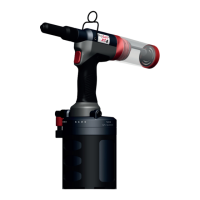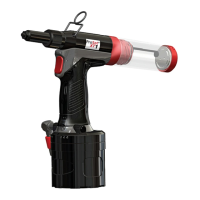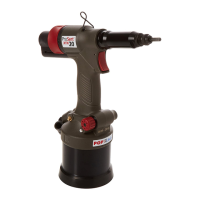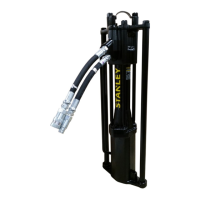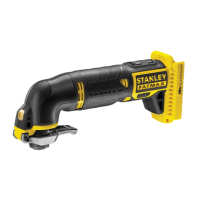3. TOOL SET UP
IMPORTANT - READ THE SAFETY WARNINGS ON PAGES 4 & 5 CAREFULLY BEFORE PUTTING INTO SERVICE.
IMPORTANT - THE AIR SUPPLY MUST BE TURNED OFF OR DISCONNECTED BEFORE FITTING OR
REMOVING THE NOSE ASSEMBLY.
3.1 NOSE EQUIPMENT REF. FIG. 2
Item numbers in bold refer to the components in gures 1 & 2 and the tables on page 8.
The XT1 tool will be supplied pre-assembled with the nose piece for 3.2mm [1/8”] rivets and nose pieces for
2.4 [3/32´´] and 4.0mm [5/32] rivets are supplied separately.
The XT2 tool will be supplied pre-assembled with nose piece for 4.0mm [5/32”] rivets and nose pieces for
3.2[1/8´´] and 4.8 [3/16´´] rivets are supplied separately.
Mounting the nose piece
• The air supply must be disconnected.
• Select the correct nose piece for the rivet to be installed.
• Remove the nose housing nut (1p) and nose housing (1d), including nose piece (1a, b or c),
and o-ring (1e) from the tool.
• Remove the nose piece (1a,b,or c) from the nose casing (1d)
• Select the relevant size nose piece and assemble in reverse order.
Removing complete nose equipment.
• The air supply must be disconnected.
• Remove the nose housing nut (1p) and nose housing (1d), including nose piece (1a, b or c), and o-ring
(1e) from the tool.
• Pull back the jaw guide lock (1m) against the spring (1n) and then remove the jaw guide (1f).
• Remove the jaws (1g) from the jaw guide (1f).
• Remove jaw pusher (1h), urethane washer (1i), and Jaw pusher spring (1j), from the pulling head (1l).
Mounting the complete nose equipment
• The air supply must be disconnected
• Any worn or damaged part should be replaced.
• Clean and check wear on jaws (1g).
• Ensure that the jaw pusher (1h) or the jaw pusher spring (1j) are not distorted.
• Lightly coat jaws (1g) with moly lithium grease.
• Drop Jaws (1g) into the jaw guide (1f).
• Insert jaw pusher (1h) and urethane washer (1i) into the pulling head (1l).
• Pull back the jaw guide lock (1m) and screw the jaw guide (1f) fully on to the pulling head (1l).
• Release the jaw guide lock (1m) and then partially unscrew the jaw guide (1f) until the jaw guide lock
(1m) tooth clicks into the next slot on the jaw guide (1f).
• Place nose casing (1d) over the jaw guide (1f) and tighten fully onto the tool.
Nose assemblies should be serviced at weekly intervals. You should hold some stock of all internal
components of the nose assembly and nose tips as they will need regular replacement.
3.2 AIR SUPPLY (Ref. g. 3.)
Components
A. Stop cock (used during maintenance of lter/regular or lubricated units)
B. Pressure regulator and lter (daily drain)
C. Main supply drain point
D. Take o point from main supply
• All tools are operated with compressed air at a minimum pressure of 5.0 bar.
• Pressure regulators and automatic oiling/ltering systems to be used on the main air supply within
3metres of the tool (see g. 3).
• Air supply hoses will have a minimum working eective pressure rating of 150% of the maximum
pressure produced in the system or 10 bar, whichever is the highest.
• Air hoses must be oil resistant, have an abrasion resistant exterior and be armoured where operating
conditions may result in hoses being damaged.
• All air hoses MUST have a minimum bore diameter of 6.4 millimetres.
• Check for air leaks. If damaged, hoses and couplings must be replaced by new items.
• If there is no lter on the pressure regulator, bleed the airline to clear it of accumulated dirt or water
before connecting air hose to the tool.
3.3 PRINCIPLE OF OPERATION
CAUTION - CORRECT SUPPLY PRESSURE IS IMPORTANT FOR PROPER FUNCTION OF THE INSTALLATION
TOOL. PERSONAL INJURY OR DAMAGE TO EQUIPMENT MAY OCCUR WITHOUT CORRECT PRESSURES.
THE SUPPLY PRESSURE MUST NOT EXCEED THAT LISTED IN THE PLACING TOOL SPECIFICATION
Item numbers in bold refer to the components in gures 1 & 2 and the tables on page 8.
When the pneumatic hose is connected to the placing tool, the pull and return cycles of the tool are
controlled by depressing and releasing the trigger (6) located in the handle.
• Air supply must be disconnected.
• Connect the appropriate nose equipment as described on page 9.
• Connect the pneumatic hose to the air on/o valve (7).
• Connect the pneumatic hose mains air supply.
• Switch on the mains supply to the tool by sliding the air on/o valve (7) to the up position.
• Air is now be supplied to the tool and the vacuum system is in operation.
• Pull and release the trigger (6) a few times to the full stroke of the tool to check operation. Observe action
of tool. Check for uid and/or air leaks.
4. OPERATION PROCEDURE
4.1 TOOL OPERATION REF. FIG. 1, 4, 5, 6
Installing a blind rivet
• Ensure that the mandrel collector (3) is tted.
• Insert rivet mandrel into the nose piece (1a, b or c). The vacuum system will retain the rivet in the nose
piece.
• Position the tool.
• Ensure nose equipment is at right angle (90°) to the work piece.
• Pull and hold trigger (6) until the rivet is fully set in the application.
• When the rivet has been set completely, release the trigger (6). The tool will return to its initial position
automatically. The mandrel is automatically dropped into the mandrel collector (3) by the vacuum system.
• Mandrel collector must be emptied before it is half full.
CAUTION –DO NOT FORCE THE INSERTION OF A RIVET MANDREL OR RIVET BODY. THIS WILL CAUSE
DAMAGE TO THE TOOL AND/OR APPLICATION.
4.2 EMPTYING THE MANDREL COLLECTOR. REF. FIG. 1
CAUTION - DO NOT USE THE TOOL WHEN THE MANDREL COLLECTOR IS REMOVED
• he tool is tted with a quick connect/release mandrel collector (3).
• A 60˚ rotation removes or replaces the mandrel collector.
• Removing the mandrel collector (3) from the tool automatically turns OFF the vacuum rivet retention and
mandrel extraction system.
• Retting the mandrel collector turns the vacuum system ON.
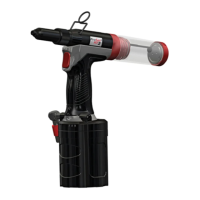
